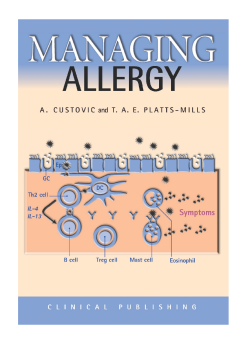
Additional Information
Book Details
Abstract
A practical book for clinicians setting out the options for effective management of chronic disease. There have been enormous advances in knowledge and understanding of the scientific and clinical aspects of allergic disorders over recent years. This book provides an evidence-based overview of therapy for allergy, showing how increased understanding translates into clinical practice, with a discussion of promising future therapeutic agents. This comprehensive review volume provides clinicians with a thorough understanding of the factors which will enable them to formulate an appropriate strategy for treatment and long-term management for each individual patient.
Table of Contents
| Section Title | Page | Action | Price |
|---|---|---|---|
| About This Book | |||
| 7 Section A: Identifying the Nature of the Task | |||
| 9 Chapter 1 Communication | |||
| 9 Communication as a Process | |||
| 10 Source | |||
| 10 Message | |||
| 11 Channel | |||
| 1 1 Audience | |||
| 12 Effects | |||
| 12 Feedback | |||
| 13 Communication as Common Understanding | |||
| 14 Problems in Communication | |||
| 17 Chapter 2 Audience and Message | |||
| 1 7 Finding Out about the Audience | |||
| 1 8 How to Find Out | |||
| 1 9 Steps in a Simple Survey | |||
| 28 Preparing the Message | |||
| 30 Deciding on the Topic | |||
| 30 Studying the Topic | |||
| 32 Chapter 3 Aims and Objectives | |||
| 32 Aims | |||
| 32 Objectives | |||
| 33 Motivation | |||
| 35 Section B: Making Choices — Methods and Media | |||
| 37 Chapter 4 The Range of Possibilities | |||
| 37 Factors in Making a Choice | |||
| 37 A Multi-Media Approach | |||
| 40 Methods and Media — An Overall View | |||
| 41 Chapter 5 Narrowing the Field | |||
| 41 Communication Methods | |||
| 41 Learning through Achievement | |||
| 42 Simulation: Models, Games, Drama, Puppetry | |||
| 44 Story-telling | |||
| 44 Song | |||
| 45 Discussion | |||
| 45 Field Trip | |||
| 45 Demonstration | |||
| 46 Talk or Lecture | |||
| 46 Exhibition | |||
| 47 Low-Cost Media | |||
| 48 Sound Recordings | |||
| 48 Visual Aids:_ Projected, Three-Dimensional, Printed Material | |||
| 52 Case Study Exercise | |||
| 5 7 Section C: Using Printed Material | |||
| 59 Chapter 6 Why Use Printed Material? | |||
| 59 What is Printing? | |||
| 59 Advantages of Printed Material as a Medium | |||
| 59 Disadvantages and Problems | |||
| 60 Low-Cost Printing | |||
| 60 Centralized and Local Production | |||
| 61 Some Possible Alternatives | |||
| 62 Chapter 7 Forming the Message | |||
| 6 2 Contents | |||
| 62 Information | |||
| 64 Approach | |||
| 65 Writing Simply | |||
| 67 Choosing Illustrations | |||
| 67 Picture Recognition | |||
| 69 Picture Style | |||
| 71 Symbols | |||
| 73 Diagrams | |||
| 75 Using Illustrations | |||
| 7 9 Pretesting | |||
| 83 Using a Questionnaire | |||
| 86 Analysing Findings | |||
| 90 Some Final Comments | |||
| 91 Glossary | |||
| 94 References | |||
| 95 Bibliography |
